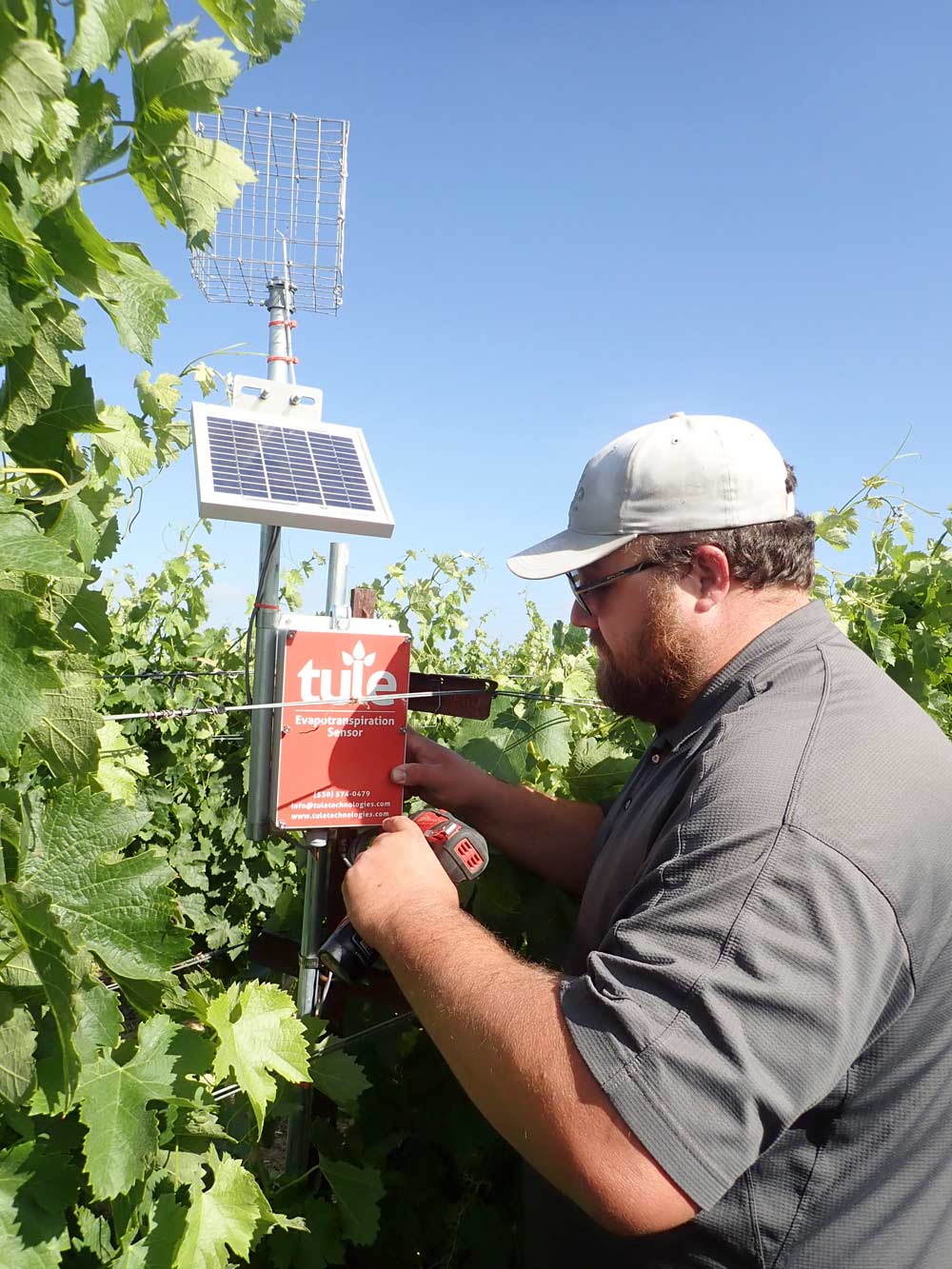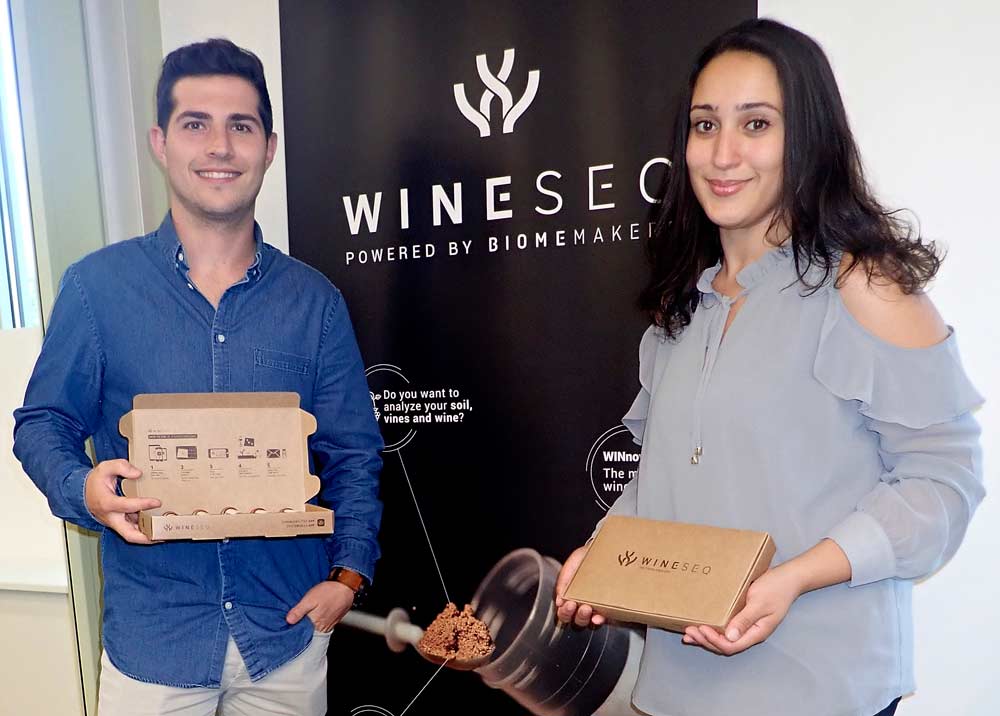
Although WineSeq was launched just a year ago, Biome Makers has already processed more than 3,000 soil samples from 200 client vineyards and wineries worldwide, including 120 in California.
(Photo by Leslie Mertz)
Just how much water should you add to your vineyard, and what soil amendments should you use to avoid disease and get the most from your grapes?
Two new products aim to answer those questions for wine grape growers. One almost magically determines the water needs for 3 acres of vineyard from a single sensing device and also makes irrigation recommendations, while the other identifies the mix of good and bad microbes in a soil sample to help with making adjustments to the soil to reduce disease risk and meet grape-harvesting and winemaking goals.
The products are among five technologies selected by the Wine Industry Network for its latest WINnovation Awards. (For more on the awards, visit www.wineindustryadvisor.com/winnovation).
FieldStat for irrigation
FieldStat Forecasts, produced by Tule of Oakland, California, uses sensors to pluck a vineyard’s water-use information right out of the air, said Tom Shapland, who co-founded Tule and now serves as its chief executive officer.
The sensors measure airborne water vapor, which reveals evapotranspiration, or the always-changing plant use of water. “What really makes this technology different is we can measure evapotranspiration over a broad area, and that has implications for irrigation management, which is core to how a farm field works,” he said.
Besides evapotranspiration data, the FieldStat system monitors vine water-stress levels “that tell how thirsty the plants are,” as well as how much watering the vineyard manager is doing, Shapland said.
“This technology answers two fundamental questions about irrigation. The first is: What is the water status of my plants relative to my production goals, such as higher yield versus high quality? And the second is: Given the water status in my field compared to my target, how much do I need to irrigate to modify that stress level?”
The company’s newest technology, FieldStat Forecasts, which became available last year, also looks a bit into the future. Currently, growers keep their own mental pictures of their fields and their varying water requirements, he said, but this technology essentially “uploads their minds to a machine.” Growers can then use what he calls “scenario planning” to run simulations of different irrigation practices for the coming week to see how their vines will respond and, ultimately, make better irrigation decisions.

Tule technician Kevin Green adjusts the FieldStat system at Buchli Station in Napa, California. It is one of 300 systems installed on Napa Valley vineyards. The company’s newest technology, which became available last year, helps growers run simulations so they can plan their irrigation practices for the coming week.
(Photo by Leslie Mertz)
Grower response to the FieldStat Forecasts feature has been very good, Shapland said. “They are telling us that they are making more money through the yield size or the quality of their crop by using our technology. For example, one of our growers looked at our FieldStat Forecasts and saw that her site was going to dry down during the Labor Day heat wave, so she followed the irrigation recommendations and came out on the other side with no fruit desiccation, but all of her neighbors had shriveled fruit,” he said.
Currently, Tule has more than 1,000 of its devices in the fields of 200-plus California growers. About three-quarters are in vineyards, 20 percent in tree fruit orchards, and 5 percent in corn and other annual crops. The next step for the company is to expand to new markets, starting first with Washington, Oregon and Arizona.
At the same time, Shapland said the company is working on season-long forecasting capabilities and is considering tying its technology to irrigation valve automation. With the latter, FieldStat’s monitoring and prognostication capabilities could trigger automatic watering.
“Things are moving fast, and it’s hard to know exactly where we’ll end up or what will happen next,” Shapland said. “It’s pretty exciting.”
WineSeq for soil

Mehrpour and Francisco De Frutos, business development manager at Biome Makers, show off the easy-to-use WineSeq kit. Growers need only put small soil samples in the tubes, mail them in, and wait a few days for the results.
(Photo by Leslie Mertz)
WineSeq, a product of Biome Makers of West Sacramento, California, emphasizes the collection of bacteria, fungi, protists and other microbes in vineyard soil, vines, grapes or must, and how that microbial diversity is linked to agricultural practices, according to Adrián Ferrero, co-founder and chief executive officer of Biome Makers. WineSeq takes a few ounces of vineyard soil, completes a DNA analysis of the microbes to determine which are present, and then employs a high-tech computing system to determine how healthy — or unhealthy — the soil is.
The computing system is the key to WineSeq. It combines data from thousands of scientific studies about vineyard-soil microbes and wades through it all to make sense of the complex interactions between microbes, Ferraro said. In addition, the researchers are continually adding new data collected from different vineyards via WineSeq, so the system will become increasingly more precise as more growers and winemakers participate.
Although the science behind it is complicated, WineSeq is easy for growers and winemakers to use.
“All they have to do is collect 2 to 4 ounces of soil from the vineyard, send it to our lab, and we tell them what they need to know to get the most out of their grapes and wines,” Ferrero said. Clients receive a simple summary of microbial diversity, so they can begin to understand how their agricultural practices are affecting soil health. They also receive a report on the vines’ vulnerabilities to diseases.
“For diseases, we are not searching for specific microbes with WineSeq, but rather we are looking at the whole community of microbes,” he said. For example, the analysis may uncover a pathogenic microbe side by side with a biocontrol microbe that is keeping the pathogenic one in check. “That means you may have no disease symptoms because your community of microbes is in balance at the moment, but you still have a risk for disease from that pathogen,” he said. Besides the disease-risk information, WineSeq offers recommendations about preventative measures to lower risks, as well as treatment options to mitigate diseases that have cropped up.
Another feature lends itself to winemaking, because WineSeq can also measure the fermentative species in the soil and provide insight into the potential for modifying the terroir by trying new combinations of species. “This allows the winemaker not only to control the process, but to drive the process, and to make changes or to do precision enology to make the wine unique,” Ferraro said.
Biome Makers also offers an expanded product called WineSeq Biosustainability, which is designed to assess the effect of any product or farming practice by providing before-and-after analyses of the soil microbiome. Since the microbiome responds quickly, he noted, growers can often see the effects of new products or practice changes in just a few weeks.
It’s all about giving growers and winemakers the best information available and in an easy-to-use format, Ferraro said. “When it comes to growing grapes or making wine well, you need the proper tools. That’s what we are providing.” •
—by Leslie Mertz






Leave A Comment